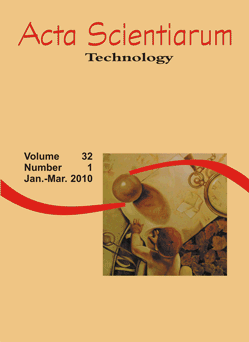<b>Peroxidase and polyphenoloxidase activity in tomato <em>in natura</em> and tomato purée</b> - DOI: 10.4025/actascitechnol.v32i1.4828
DOI:
https://doi.org/10.4025/actascitechnol.v32i1.4828Palavras-chave:
tomato, oxidative enzyme, isoenzyme, isolation, thermostabilityResumo
Oxidative enzymes are responsible for changes in flavor, texture, color and also in some nutritive properties of several fruits and vegetables processed in industries. The present investigation aimed to study the activity of Peroxidase (E.C. 1.11.1.7) and Polyphenoloxidase (E.C. 1.10.3.1) in tomato fresh pulp in natura and in three different trademarks of tomato purée sold in supermarkets. Crude extracts of peroxidase (POD) and polyphenoloxidase (PPO) enzymes, from both fresh tomato pulp in natura and processed tomato purée, purchased in supermarkets, were prepared, by using sodium phosphate buffer at different pHs. The best pH values for extraction of peroxidase and polyphenoloxidase were 6.2 and 7.5, respectively. Protein precipitations were carried out using acetone at the ratio of 1:2 enzymatic extract/acetone. The enzymatic extract from Santa Clara tomato cultivar was concentrated 10 times, before being applied to the chromatographic column packed with Sephacryl 100-HS. From the samples eluted, one isoenzyme was isolated (A1) and the molecular weight and isoelectric point (pI) was determined (MW 45 kDa and pI 4.5). The fraction with A1 was stored at -18°C, and later used for thermostability studies. A decrease in the enzymatic activity was observed at 85 and 90°C, in the enzymatic extracts obtained from fresh tomato pulp; nevertheless, in the processed tomato purées the loss of activity was more significant.Downloads
Downloads
Publicado
Como Citar
Edição
Seção
Licença
DECLARAÇíO DE ORIGINALIDADE E DIREITOS AUTORAIS
Declaro que o presente artigo é original, não tendo sido submetido í publicação em qualquer outro periódico nacional ou internacional, quer seja em parte ou em sua totalidade.
Os direitos autorais pertencem exclusivamente aos autores. Os direitos de licenciamento utilizados pelo periódico é a licença Creative Commons Attribution 4.0 (CC BY 4.0): são permitidos o compartilhamento (cópia e distribuição do material em qualqer meio ou formato) e adaptação (remix, transformação e criação de material a partir do conteúdo assim licenciado para quaisquer fins, inclusive comerciais.
Recomenda-se a leitura desse link para maiores informações sobre o tema: fornecimento de créditos e referências de forma correta, entre outros detalhes cruciais para uso adequado do material licenciado.















